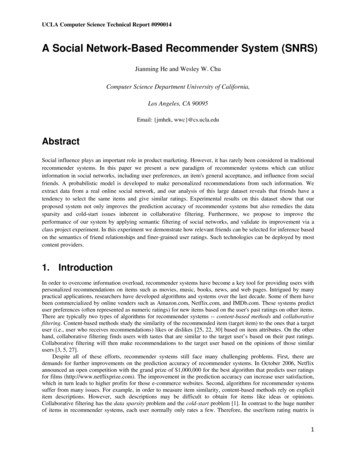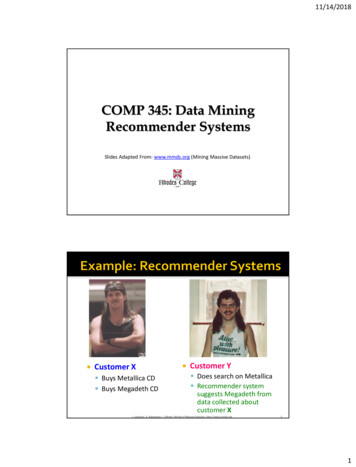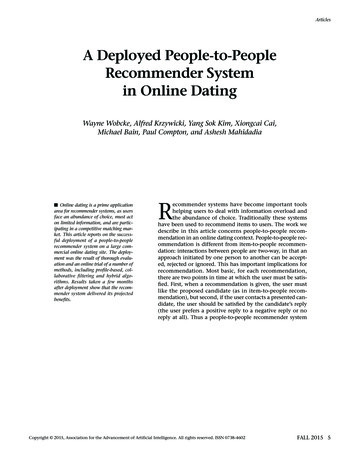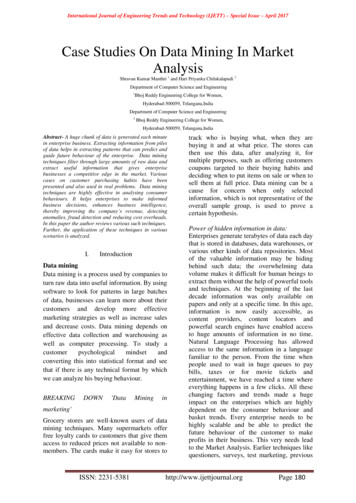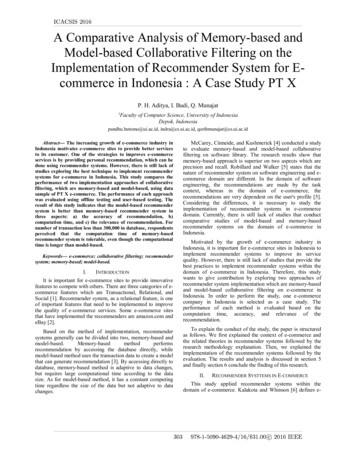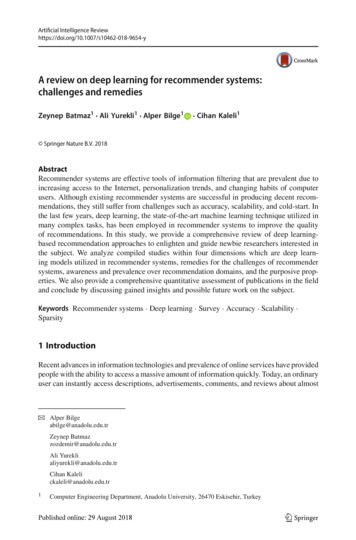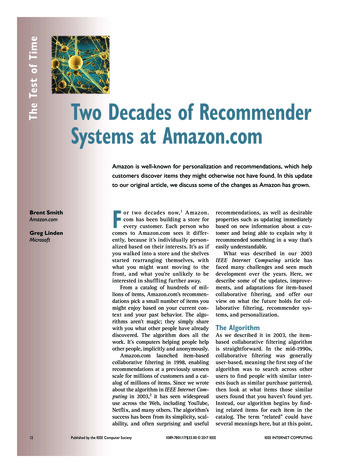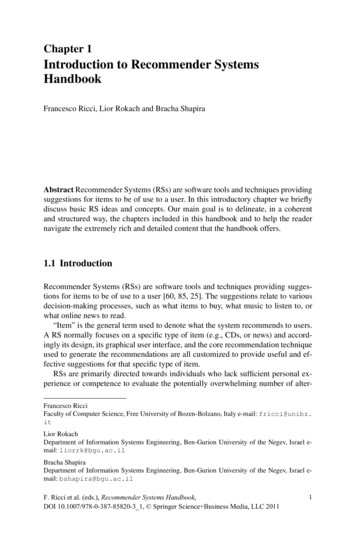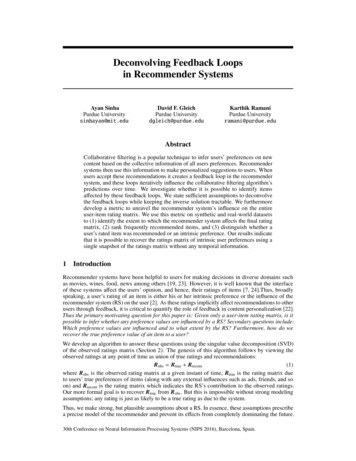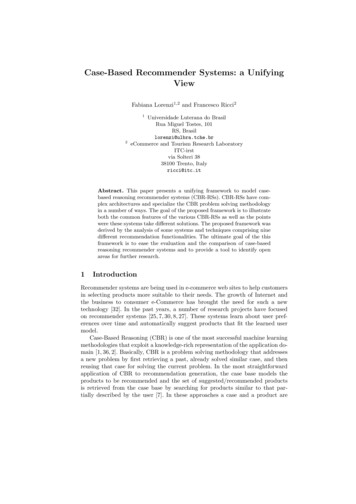
Transcription
Case-Based Recommender Systems: a UnifyingViewFabiana Lorenzi1,2 and Francesco Ricci212Universidade Luterana do BrasilRua Miguel Tostes, 101RS, Brasillorenzi@ulbra.tche.breCommerce and Tourism Research LaboratoryITC-irstvia Solteri 3838100 Trento, Italyricci@itc.itAbstract. This paper presents a unifying framework to model casebased reasoning recommender systems (CBR-RSs). CBR-RSs have complex architectures and specialize the CBR problem solving methodologyin a number of ways. The goal of the proposed framework is to illustrateboth the common features of the various CBR-RSs as well as the pointswere these systems take different solutions. The proposed framework wasderived by the analysis of some systems and techniques comprising ninedifferent recommendation functionalities. The ultimate goal of the thisframework is to ease the evaluation and the comparison of case-basedreasoning recommender systems and to provide a tool to identify openareas for further research.1IntroductionRecommender systems are being used in e-commerce web sites to help customersin selecting products more suitable to their needs. The growth of Internet andthe business to consumer e-Commerce has brought the need for such a newtechnology [32]. In the past years, a number of research projects have focusedon recommender systems [25, 7, 30, 8, 27]. These systems learn about user preferences over time and automatically suggest products that fit the learned usermodel.Case-Based Reasoning (CBR) is one of the most successful machine learningmethodologies that exploit a knowledge-rich representation of the application domain [1, 36, 2]. Basically, CBR is a problem solving methodology that addressesa new problem by first retrieving a past, already solved similar case, and thenreusing that case for solving the current problem. In the most straightforwardapplication of CBR to recommendation generation, the case base models theproducts to be recommended and the set of suggested/recommended productsis retrieved from the case base by searching for products similar to that partially described by the user [7]. In these approaches a case and a product are
essentially considered as identical objects. The problem component of the caseis typically represented by a set of product features, those specified by the user,and the solution component of the case is the product itself.In the basic usage scenario, the customer is looking for some product topurchase. He/she makes explicit some requirements about the product beingsearched for and the system searches the case base for products that matchthe user requirements. The retrieval process is driven by a similarity metric thatcomputes the similarity of the problem description, i.e., the current user requirements and the products in the case base. A set of cases products is then retrievedfrom the case base and these products are recommended to the user. If the useris not satisfied with these suggestions he/she can modify the requirements in thequery and a new recommendation cycle is started.In a Case-Based Reasoning Recommender System (CBR-RS) the effectiveness of the recommendation is based on: the ability to match user preferenceswith product description; the tools used to explain the match and to enforce thevalidity of the suggestion; the range of available functionalities and the graphicalinterface that support the user in browsing the information content, either thecases or the products to recommend.In this paper we propose an interpretation framework that models how CBRRSs behave. We have derived this model by an analysis of the literature, thateven if not complete, includes a good number of radically different approaches.In carrying out such an analysis we realized that the literature is fragmented andeven contradictory in explaining the effective adoption of the CBR methodologyto generate recommendations. The proposed framework: a) specializes the general CBR steps to the recommendation task; b) describes how a recommendersystem exploits the classical CBR learning loop (retrieve-reuse-revise-reviewretain); and c) illustrates how different classes of CBR-RSs further specializethe general CBR model.To validate the framework we considered several approaches recently developed either as techniques or as full recommender systems. For instance, Entree[7], is a restaurant recommender system that provides recommendations by finding restaurants in a new city similar to restaurants the user knows and likes.The Interest Confidence Values [22] is a recommendation technique where a newproduct (restaurant) is suggested reasoning on the explicit and implicit user’s interests on previously considered products, that are stored in the case base. Thisapproach exploits also a forgetting mechanism that allows the system to distinguish between current and old interests. In the Comparison-Based Retrievaltechnique [16] is used a preference-based feedback approach that transforms theuser’s preference into explicit query modifications. In another system, DieToRecs[28, 11], the goal is to help the user to plan a leisure trip. DieToRecs is able topersonalize the current recommendation on the base of previously stored recommendation sessions (cases). In the Compromise-Driven Retrieval technique casesare retrieved and grouped according to the compromises done by the system, i.e.,the user requirements which cannot be satisfied, and therefore are relaxed by theretrieval algorithm [17]. In the Order-Based Retrieval technique [4] a number of
different order relationships among cases are managed to optimally sort the recommended products.In summary, the goal of this paper is to present a good sample of CBR-RSsand explain the proposed methods using a unifying notation that will ease thereader in understanding their relationships, respective benefits and shortcomings. We aim at offering this research as a starting point for further analysis,identifying still unexplored solutions and therefore motivating new research inthe field.The paper is organized as follow. A brief overview of recommender systemtechnologies is given in the next section. Section 3 describes the whole CaseBased Reasoning process and how it is used in recommender systems. Section4 discusses the proposed framework. Section 5 illustrates the chosen examplesof recommendation techniques and discusses how they fit in the interpretationframework. Section 6 presents a summary comparison of the techniques presentedin the previous section. Finally, Section 7 summarizes the conclusions of thepaper.2Recommender SystemsIn the past years, a number of research projects have focused on recommendersystems [25, 31, 32]. These systems try to learn user preferences over time andto automatically suggest products that fit the learned user model. E-commercesites are using recommender systems to suggest products to their customers andimprove the look to buy ratio.The most popular recommendation technique is collaborative filtering thataggregates data about customer’s preferences (products’ ratings) to recommendnew products. Amazon.com is a very popular example of an e-Commerce sitethat exploits a collaborative-filtering approach. In its book section for instance,the system encourages direct feedback from customers about books they alreadyread [32]. After this, the customer may request recommendation for books thathe/she might like. Another notable example is MovieLens [19], a well-knownmovie recommender system that bases its recommendations on collaborativefiltering as well.Content-based filtering is another recommendation technique that basicallyexploits the preferences (past and current) of a specific customer to build newrecommendations to the customer. NewsDude [3], for instance, observes whatonline news stories the user has read and not read and learns to present theuser with articles he/she may be interested to read. Content-based systems areusually implemented as classifier systems based on machine learning research[37].In collaborative filtering the recommendation depends on customers’ information, and a large number of previous user/system interactions are required tobuild reliable recommendations. In content-based systems only the data of thecurrent user are exploited in building a recommendation. It requires a descriptionof user interests that is either matched in the items’ catalog or provided as input
for the learned user model to output a recommendation. Both approaches, if nottrained with lot of examples (product ratings or pattern of user preferences), deliver poor recommendations. This limitation mostly motivated a third approach,knowledge-based, that tries to better use preexisting knowledge specific of theapplication domain (e.g. travels vs. computers) to build a more accurate modelrequiring less training instances.The knowledge-based approach is considered complementary to the other approaches [7]. In this approach, knowledge about customers and the applicationdomain are used to reason about what products fit the customer’s preferences.The most important advantage is that this approach does not depend (exclusively) on customer’s rates, hence avoiding the mentioned difficulty in bootstrapping the system. Knowledge can be expressed as a detailed user model, a model ofthe selection process or a description of the items that will be suggested. However, the usually complex and error prone process required for extracting therequired knowledge and building the needed models (knowledge representation),is seen as a limitation of this approach.Knowledge-based recommender system can exploit similarity metrics. Forexample, in the e-commerce portal site recommender.com [7] the system usesknowledge about the customer (the movie’s name that the user liked) to searchin the database (catalog) for similar movies. The retrieved set is sorted by thesimilarity to the input movie and the top candidates are recommended to theuser. We will further discuss this knowledge-based approach in the next Section.3Case-Based ReasoningCase-based reasoning (CBR) is a problem solving methodology that tries to solvenew problems by re-using specific past experiences stored in example cases [12].A case models a past experience, storing both the problem description and thesolution applied in that context. All the cases are stored in the case base. Whenthe system is presented with a new problem to solve, it searches for the mostsimilar case(s) in the case base and reuses an adapted version of the retrievedsolution to solve the new problem.CBR is a cyclic and integrated problem solving process (see Figure 1) thatsupports learning from experience [1] and has four main steps: retrieve, reuse,adaptation and retain [12]. The adaptation phase is split into two sub-steps:revise and review. In the revise step the system adapts the solution to fit thespecific constraint of the new problem. Whereas in the review step the constructed solution is evaluated by applying it to the new problem, understandingwhere it fails and making the necessary corrections.In a diagnosis task, for instance, the system acquires the patient symptoms(new problem) and tries to give the final diagnosis based on past patient examples (stored in the case base). Sometime the solution retrieved can be straightforwardly reused in the new problem, but in the majority of the situations theretrieved solution is not directly applicable and must be adapted to the specific
Fig. 1. Case-Based Reasoning problem solving cycle [2]requirements of the new problem. After this adaptation the system creates anew case and could retain it in the case base (learning).A fundamental issue in CBR is the case model. This must account for boththe problem and solution components. It is necessary to decide which attributesshould compose a case and what representation language is better suited to represent the particular knowledge involved in the problem solving process. Hence,the case representation task is concerned with (1) the selection of relevant attributes, (2) the definition of indexes and (3) structuring the knowledge in aspecific case implementation. Indexing is related to the creation of additionaldata structures that can be held in the memory to speed up the search process focussing on the most relevant dimensions. The indexes identify the caseattributes that should be used to measure case similarity. Moreover, indexes canspeed up the retrieval process by providing fast access to those cases that mustbe compared with the input case problem. For instance, in a medical diagnosissystem, if the system must produce an infection diagnosis then attributes suchas profession, gender or age are probably less important than the attributesdescribing the symptoms.4Methodology for the CBR Recommender SystemsIn this section we shall illustrate how the generic steps of the CBR problemsolving cycle are specialized in a CBR Recommender System, hence providinga unifying description of various systems or techniques. Whereas in the next
Section we shall illustrate some real CBR-RSs and the techniques exploited togenerate the recommendations.In the simplest recommendation process, the user is supposed to be lookingfor some product to purchase and therefore is asked by the system to providesome product requirements, those that he/she considers as the most important.In reply, the system initiates a search in the case base to identify products thatshould be recommended, i.e. those that satisfy these requirements. In this processwe can identify some basic elements, such as, the input (where the user provideshis/her requirements), the products retrieval (where the system searches theproducts according to user requirements) and the output, where some recommendation is given to the user.As described in the previous section this flows is very similar to that of ageneric CBR system. This starts with a new problem, retrieves similar cases fromthe case base, shows the retrieved solution to the user or adapts it to better solvethe new problem and terminates the process retaining the new case.We have therefore analyzed four CBR recommender systems and six recommendation techniques and through this analysis we created a condensed modelof these recommendation approaches. This model is a general framework for accommodating the description of the specific tasks/functionalities available in theconsidered systems for product recommendation. Using the framework a numberof approaches can be described as specific instantiation of the different steps ofthe CBR cycle and the evaluation and the comparison of CBR-RSs can be eased.The CBR recommender systems that we have analyzed are:– Entree (EN): a recommender system that exploits query tweaking to recommend restaurants to the user.– DieToRecs (DTR): a travel recommender system that suggests both singletravel services (e.g. hotel or an event) and complete travel plans comprisingmore that one elementary service.– First Case (CDR): a prototype system that uses the Compromise-DrivenRetrieval technique to retrieve and group cases according to the alternativecompromises found by the system.– Expertclerk (EC): a tool for developing dialogue-based recommender systemsfor e-commerce websites.The recommendation techniques that we have analyzed, either included insome of the previously mentioned systems or not yet exploited in any prototype,are:– Interest Confidence Value (ICV): a similarity-based retrieval technique thatis used to predict the interest of a user in a product. This technique introduces also a mechanism to progressively forget old not useful cases.– Single Item Recommendation (SIR): a recommendation technique introduced in the DieToRecs system (DTR) to recommend a single item (product).– Seeking for Inspiration (SI): this technique, used in DieToRecs, updatestravel plans recommendations according to explicit user feedbacks.
– Travel completion (TC): a recommendation technology introduced in DTRto recommend a complete travel a partially defined plan.– Order-based retrieval (ODR): a retrieval technique based on the applicationof partial order operators to the case base.– Comparison-based Retrieval (COB): this technique transforms user’s preferences into explicit query modifications.Figure 2 shows the framework including the classical five steps of the CBRproblem solving cycle plus an additional ”iterate” step. The iterate step modelsa peculiar feature of many RSs, i.e., to incrementally update the current setof recommendations acquiring new input from the user, usually in the form ofcritics or feedbacks. In each stage we list in bold face a general description ofthe technique or data and then the recommendation techniques or systems thatexploit such general technique or data. For instance, in the ”Input” box we have”product features” used by the SIR (Single Item Recommendation) techniqueof the DieToRecs system. All the details and acronyms mentioned in this figurewill be explained in the following sections. We provide here a general descriptionof this framework as an introduction to the description of each single techniqueor system.Fig. 2. CBR recommender systems frameworkThe first stage of many recommendation techniques is the input where thesystem interacts with the user to capture her preferences. According to [24] thereare different strategies for interacting with the user. The most popular strategyis dialog-based, where the system offers guidance to the user by asking questionsand presenting products alternatives, to help the user to decide. Several CBR
recommender systems ask the user’s requirements to have an idea of what theuser is looking for. In the Compromise-Driven Retrieval [18], for instance, theuser provides the (case) features of a personal computer that he/she is lookingfor, such as, type, price, processor or speed. Expertclerk [34] asks directly to theuser to answer some questions and hence to provide case features as replies tothese questions.Usually when the user searches for a product, three situations can occur [6,24]:– the user knows exactly what he/she wants;– the user has a desire but does not know the name of the product;– the user does not know precisely what he/she is looking for.In each of these situations, to recommend suitable alternative products thesystem requires some kind of knowledge. In CBR-RSs the knowledge is mainlystored in the case base and analyzing the existing CBR-RSs we noticed that theknowledge contained in a case can refer to many characteristics of the problemdomain. In fact, in the systems that were considered for this study, a case storesinformation about: the products recommended (or to be recommended), the userto whom the recommendation was supplied, and contextual information aboutthe recommendation session when the recommendation was provided. Actually,the systems exploits these basic ingredients to define their own specific casemodel as a mix of these. Hence, for instance, in one case model we may find adescription of the recommended products and user who received the recommendation or the user together with his recommended products’ evaluation.To compare different CBR-RSs we propose here an artificial case model thatincludes case components found in these RSs. In this perspective a case baseCB, can be decomposed in four sub-components:CB X U S Ewhere X is the product/content model, U is the user model, S is the sessionmodel, and E is the evaluation model (more details on these models are providedbelow). This means that a general case c (x, u, s, e) CB in a generic CBRRS consists of four (optional) sub-elements x, u, s, e which are instances of thespaces X, U, S, E respectively. Each CBR-RS adopts a particular model for thespaces X, U, S, E. These spaces could be empty, vector, set of document (textual),labelled graphs, etc. Let us now describe each model separately.– Content model (X): the content model describes the product recommendedor to be recommended, and usually adopts a feature-based representationof the product (feature vector). In Compromise-Driven Retrieval [18], forinstance, a case is modelled (only)Qby the content component, which is annn-dimensional vector space X i 1 Xi . Each Xi represents the set ofpossible values for a product attribute. For instance, when the products arecomputers, an attribute (symbolic) could be the computer type, or the priceof the computer (numeric).
– User model (U): the user model usually contains personal user information,such as, name, address, age or information about the user past system usage,such as his/her preferred products. Very few CBR-RSs have exploited thiscomponent.– Session model (S): the session model is introduced to collect informationabout the special recommendation session (problem solving loop). In DieToRecs, for instance, a case describe a recommendation session and storesall the user queries and product selected in that session.– Evaluation model (E): the evaluation model describes the outcome of therecommendation, i.e., if the suggestion was appropriate or not. This couldbe a user a-posteriori evaluation, or, as in [22], the outcome of an evaluationalgorithm that guesses the goodness of the recommendation (exploiting thecase base of previous recommendations).Actually, in CBR-RSs, as we noticed above there is a large variability in whata case really models and therefore what components are really implemented.There are systems that use only the content model, i.e, they consider a case asa product, and other systems that focus on the perspective of cases are recommendation sessions. The example systems described in the following sections willillustrate this variability in case structure.Going back to the problem solving cycle, let us now consider more in detailhow cases are managed by different approaches. The first step of the recommendation cycle is the retrieval phase. This is typically the main phase andthe majority of CBR recommender systems can be described as sophisticated retrieval engines. For example, in Order-Based Retrieval [4] the system uses specialoperators to retrieve a lattice of cases, or in the Compromise-Driven Retrieval[18] the system retrieves similar cases from the case base but also groups thecases, putting together those cases that offer the same compromise to the userand presents to the user just a representative case for each group.After the retrieval, in the reuse stage the case solution is considered andthe system evaluates if it can be reused in the current problem or what part ofthe case can be reused. In the simplest CBR-RSs, the system reuse the retrievedcases/products showing them to the user. In more advanced solutions, such asin ICV [22] or DTR [28], the retrieved cases are not recommended but used torank candidate products identified with other approaches, for instance in DTR,with an interactive query management component.In the next phase revise the reused case is adapted to better fit the newproblem. The review phase in CBR-RSs is implemented by allowing the userto customize the retrieved set of products. For instance in DieToRecs the usercan add to the current case other products either using the CBR functionalityor by using other system functions (e.g. browsing the product catalogue).The iterate step is implemented very often in conversational systems. Forexample, In Entree [7] the system allows the user to tweak the initial query andsearch for products having marginal differences with those already shown, withrespect to some of the product features (e.g. cheaper products). In Comparisonbased Retrieval [16] the system asks the user to provide feedback, either positive
or negative, about the retrieved product and automatically updates the userquery using this information.The last step of the CBR recommendation cycle is the retain phase (orlearning), where the new case is retained in the case base. In DieToRecs, forinstance, all the user/system recommendation sessions are stored as a new casesin the case base.The next subsections describe some representative CBR-RSs, focusing ontheir peculiar characteristics.55.1CBR Recommendation Techniques and SystemsEntree - ENEntree is a restaurant recommender system that provides recommendations byfinding restaurants in a new city similar to restaurants the user knows and likesor those matching some user goals (case features)[7].The user starts the interaction with Entree, as showed in Figure 3, eitherby: mentioning a known restaurant in some place (source case) and asking for asimilar one in a give city; or selecting a set of high-level features (case features)and searching for a restaurant that matches those features. With this inputinformation, the system first selects from the database, which physically storesthe cases, the set of all restaurants that satisfy the largest number of logicalconstraints generated by considering the input features type and value. Thesystem, if necessary, implicitly relaxes the lowest important constraints untilsome restaurants could be retrieved.Then Entree sorts the retrieved cases using a similarity metric. This similaritymetric assumes that the user goals, corresponding to the input features (or thefeatures of the source case), could be sorted to reflect the importance of suchgoals from the user point of view. Hence the global similarity metric sorts theproducts first with respect the most important goal and then iteratively withrespect to the remaining goals (multi-level sort).If the recommended restaurants satisfies the user then the interaction finishes. But if the user is not satisfied, because of the values of some featuresof the proposed restaurant, then he can criticize them. This failure situationis determined by the fact that in the similarity retrieval it is possible that therecommended restaurant does not match 100% the good example provided bythe user as input. If for instance, the price is too high and the user is looking forsomething cheaper, then he/she can ”tweak” the original request and provide anew input explicitly mentioning that the result must have a cheaper price. Thisstarts a new recommendation cycle and the criticized features is considered themost important user goal.In Entree the reuse step is trivially implemented, i.e. the products retrievedare passed to the revise step for ranking. The review and retain steps are notimplemented.
Fig. 3. Entree recommender system5.2Interest Confidence Value - ICVMontaner et al. (in [22]) assume that the user’s interest in a new product issimilar to the user’s interest in similar past products. This means that when anew product comes up, either selected by a user’s query or by another method,then the recommender system predicts the user’s interest in this product basedon the interest attributes/evaluation of similar products.A case is modelled by objective attributes describing the product (contentmodel) and subjective attributes describing implicit or explicit interests of theuser in this product (evaluation model). Formally, the case c is defined as c X E.The content model (X), in this system, is represented by a vector space XQn i 1 Xi where, for instance, x1 is the restaurant code (integer); x2 is therestaurant name (string); x3 is the restaurant address (string); x4 is the cuisinetype (string); x5 is the approximate price (real); x6 is the capacity (integer)and x7 is the air-conditioning (boolean).QmThe evaluation model (E) is also an heterogeneous vector space E i 1 Eiwhere some ei Ei describe explicit interests attributes like a general evaluation of the product provided by the user or a quality price ratio. Some other eidescribe implicit evaluation attributes like the rate of time spent by the user toread product information. There is also a special attribute, called drift attribute,that measures how recently the user expressed his interest in the product. Whenthis drift attribute becomes very small the system tends to reduce the importance of the information contained in the case associated to that product, andeventually can discard the case.As Figure 4 shows, the recommendation process starts with the user providing some preferences about a new restaurant he/she is looking for and with a
new restaurant r (source case). The goal of the system is to evaluate if this newrestaurant r could be interesting for the user. With these preferences and input product the system searches similar restaurants in the case base (retrievalphase) to find restaurants that could be used to compute the interest predictionof the new restaurant r.Fig. 4. The Interest Confidence Value techniqueIn the reuse phase the system basically extract from the retrieved cases (ci ,i 1, . . . , k) the interest attributes, or in our terminology the evaluation model.In the revise phase the system assumes that the user’s interest in the newrestaurant r is similar to his/her interest in the retrieved restaurants, hence, foreach retrieved case ci it extracts the interest attributes (evaluation model) andcompute a global interest value V (i) for each retrieved case. V (i) is a weightedaverage sum of the interest attributes multiplied by the drift attribute [22].Then a global interest confidence value I(r) for the product r is computedas a weighted average of the interest values of the retrieved cases:I(r) Pki 1PkV (i)Sim(r, ci )i 1Sim(r, ci )If the interest confidence value of the new restaurant is greater than a certainvalue (a confidence threshold), then the new restaurant is recommended to theuser. Otherwise, the CBR cycle terminates with no recommendation and thesystem just provides a negative advice to the user about the queried restaurant.The review phase is implemented by asking the user for the correct evaluation of the restaurant and after that a new case (the product and the evaluation)
is retained in the case base. Also implicit evaluation indicators are retained asderived from the analysis of the user/system interaction.We st
2 eCommerce and Tourism Research Laboratory ITC-irst via Solteri 38 38100 Trento, Italy ricci@itc.it Abstract. This paper presents a unifying framework to model case- . In collaborative filtering the recommendation depends on customers' infor-mation, and a large number of previous user/system interactions are required to build reliable .

